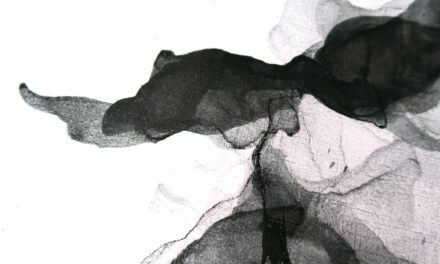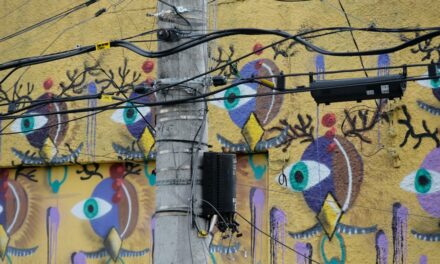Drip painting is a distinctive and dynamic form of abstract art that emerged prominently in the mid-20th century. Characterised by the technique of dripping or pouring paint onto a canvas, this method allows for spontaneous expression and the creation of intricate patterns that are often unpredictable. The artist typically uses a variety of tools, such as brushes, sticks, or even their hands, to manipulate the paint as it falls, resulting in a unique interplay of colour and texture.
This technique not only liberates the artist from traditional constraints of brushwork but also invites the viewer to engage with the artwork on a visceral level, as the chaotic yet harmonious forms evoke a sense of movement and energy. The essence of drip painting lies in its ability to convey emotion and spontaneity. Unlike more conventional painting methods that often require meticulous planning and execution, drip painting embraces chance and randomness.
This approach allows artists to tap into their subconscious, creating works that reflect their inner thoughts and feelings. The resulting pieces often appear as a visual symphony, where colours collide and blend in unexpected ways, creating a sense of depth and complexity. As such, drip painting has become synonymous with the broader movement of Abstract Expressionism, which prioritises personal expression over representational accuracy.
Summary
- Drip painting is a technique where paint is dripped or poured onto a canvas, allowing it to flow and create unique patterns and textures.
- Drip painting originated in the 1940s and 1950s, with artists like Jackson Pollock and Janet Sobel pioneering the technique as a form of abstract expressionism.
- Famous drip painters include Jackson Pollock, Helen Frankenthaler, and Sam Francis, who are known for their innovative use of the drip painting technique.
- Materials for drip painting include canvas, acrylic or oil paints, and various tools for dripping and splattering, while techniques involve different methods of applying and manipulating the paint.
- To create your own drip painting, start by preparing your workspace, choosing your colours, and experimenting with different pouring and dripping techniques to achieve your desired effect.
The History of Drip Painting
The origins of drip painting can be traced back to the early 20th century, but it gained significant prominence in the 1940s and 1950s, particularly through the work of American artist Jackson Pollock. Pollock’s innovative techniques revolutionised the art world, as he developed a method of laying canvases on the ground and allowing paint to drip from above. This approach not only transformed the act of painting into a physical performance but also challenged traditional notions of composition and perspective.
Pollock’s work was deeply influenced by Native American sand painting and Mexican muralists, which contributed to his unique style that combined elements of both abstraction and symbolism. As drip painting evolved, it became a hallmark of the Abstract Expressionist movement, which sought to express emotional intensity through non-representational forms. Artists such as Willem de Kooning and Franz Kline also experimented with similar techniques, further solidifying drip painting’s place in modern art history.
The post-World War II era saw a shift in the art world, with New York emerging as a new centre for artistic innovation. Drip painting became emblematic of this shift, representing a break from European artistic traditions and embracing a distinctly American voice. The movement not only redefined artistic practices but also influenced various other disciplines, including literature and music.
Famous Drip Painters

Jackson Pollock remains the most iconic figure associated with drip painting, often referred to as the pioneer of this technique. His works, such as “No. 5, 1948,” exemplify the chaotic beauty that can be achieved through dripping paint.
Pollock’s ability to create large-scale canvases that enveloped viewers in a whirlwind of colour and form was revolutionary. His approach was not merely about aesthetics; it was also about process and performance. By engaging with his materials in an instinctual manner, Pollock transformed the act of painting into an immersive experience that resonated deeply with audiences.
In addition to Pollock, other notable artists have made significant contributions to the drip painting genre. Helen Frankenthaler is another key figure whose work exemplifies the fluidity and spontaneity inherent in this technique. Her innovative use of thinned paint allowed for a more delicate application that created ethereal washes of colour on canvas.
Frankenthaler’s piece “Mountains and Sea” is often cited as a pivotal work that bridges the gap between Abstract Expressionism and Colour Field painting. Similarly, artists like Morris Louis and Kenneth Noland expanded upon drip techniques by incorporating colour into their compositions in new ways, further enriching the dialogue surrounding this expressive form of art.
Materials and Techniques for Drip Painting
Creating a drip painting requires a thoughtful selection of materials that can enhance the overall effect of the artwork. The primary medium is, of course, paint; however, artists often experiment with various types such as acrylics, oils, or even watercolours. Acrylic paints are particularly popular due to their quick drying time and versatility, allowing for layering and manipulation without long waiting periods.
Additionally, artists may choose to use different viscosities of paint to achieve varied effects—thicker paints create more pronounced drips while thinner paints can produce delicate lines and washes. The techniques employed in drip painting are as diverse as the artists themselves. While some may prefer to pour or drip paint directly from containers onto a horizontal canvas, others might use brushes or tools to flick or splatter paint from above.
This method not only adds an element of chance but also allows for greater control over the final composition. Many artists also incorporate mixed media elements into their drip paintings, using materials such as sand or fabric to add texture and depth. Ultimately, the choice of materials and techniques is deeply personal and reflects each artist’s unique vision and style.
How to Create Your Own Drip Painting
Embarking on your own drip painting journey can be an exhilarating experience that encourages creativity and self-expression. To begin, gather your materials: a large canvas or sturdy paper, various types of paint (acrylics are recommended for beginners), brushes or pouring containers, and protective gear such as gloves and an apron. It is also advisable to work in a well-ventilated area or outdoors to avoid inhaling fumes from the paint.
Once you have your workspace set up, consider laying down a drop cloth to protect your surroundings from any splatters. The process itself is where the magic happens. Start by selecting a colour palette that resonates with you; this could be based on emotions you wish to convey or simply colours you find appealing.
Begin by pouring or dripping paint onto your canvas from different heights to create varying effects—higher pours will result in longer drips while closer pours will create more concentrated spots of colour. Allow yourself to be spontaneous; embrace mistakes as part of the creative process. As you layer colours and experiment with different techniques, you will discover your own unique style within the realm of drip painting.
The Impact of Drip Painting on the Art World

Drip painting has had a profound impact on the art world, challenging established norms and redefining what constitutes art itself. By prioritising process over product, artists like Pollock encouraged viewers to reconsider their relationship with art—shifting from passive observation to active engagement with the creative process. This transformation has led to a broader acceptance of abstract forms in contemporary art, paving the way for future movements that embrace spontaneity and emotional expression.
Moreover, drip painting has influenced various artistic disciplines beyond visual arts. Its emphasis on performance has inspired movements in dance and theatre, where improvisation plays a crucial role in storytelling. Additionally, musicians have drawn inspiration from the chaotic rhythms found in drip paintings, leading to innovative compositions that reflect similar themes of spontaneity and emotional depth.
The legacy of drip painting continues to resonate across artistic boundaries, demonstrating its enduring relevance in contemporary culture.
Drip Painting in Contemporary Art
In contemporary art, drip painting remains a vital form of expression that continues to evolve with new technologies and materials. Many contemporary artists have adopted and adapted drip techniques while incorporating digital elements into their work. For instance, some utilise digital tools to simulate dripping effects or create interactive installations that invite viewer participation.
This fusion of traditional methods with modern technology reflects an ongoing dialogue within the art community about authenticity and innovation. Furthermore, contemporary artists are increasingly exploring themes related to identity, politics, and environmental issues through their drip paintings. By using vibrant colours and dynamic forms, they convey complex narratives that resonate with current societal concerns.
This evolution demonstrates how drip painting has transcended its origins while maintaining its core principles of spontaneity and emotional expression. As new generations of artists continue to experiment with this technique, it is clear that drip painting will remain an influential force within the ever-changing landscape of contemporary art.
Tips and Tricks for Mastering Drip Painting
To truly master drip painting, it is essential to embrace experimentation and allow yourself the freedom to explore different techniques without fear of failure. One effective tip is to start small; practice on smaller canvases or paper before committing to larger works. This approach allows you to refine your technique while building confidence in your ability to manipulate paint effectively.
Additionally, consider varying your pouring heights and angles—experimenting with different distances can yield surprising results that enhance your understanding of how gravity affects paint flow. Another valuable trick is to incorporate layering into your process. Allow each layer to dry before adding additional colours; this not only creates depth but also prevents colours from becoming muddied or overly blended.
You might also explore using unconventional tools—such as sponges or even household items—to create unique textures within your work. Finally, remember that there are no strict rules in art; embrace your individuality and let your intuition guide you as you create your own distinctive drip paintings that reflect your personal style and vision.
For those intrigued by the innovative techniques of modern art, particularly drip painting, it might be equally enriching to explore other significant art movements and their unique styles. A recommended read would be An Introduction to Neoclassicism, which delves into a period that emphasised simplicity and symmetry, contrasting markedly with the spontaneous and dynamic nature of drip painting. Understanding the disciplined precision of Neoclassicism could provide a deeper appreciation of the freedom and fluidity found in modern art techniques.




